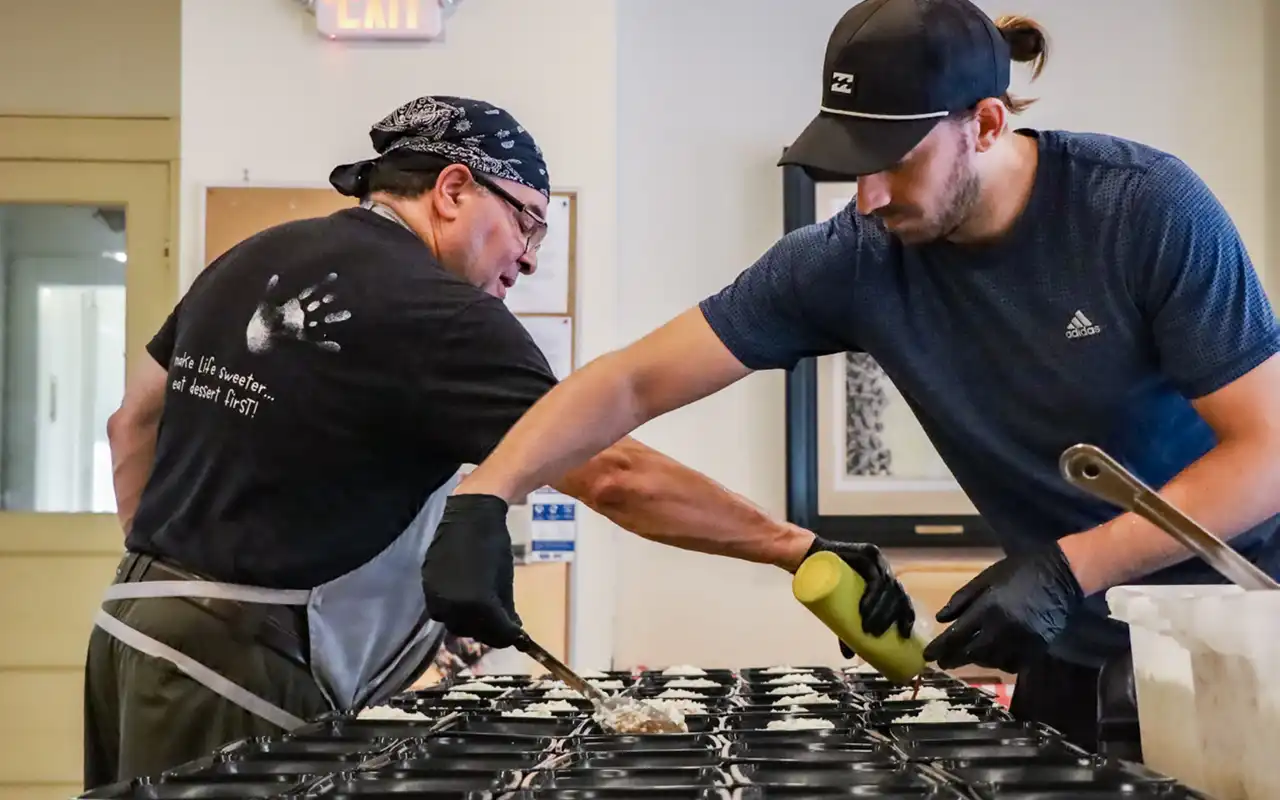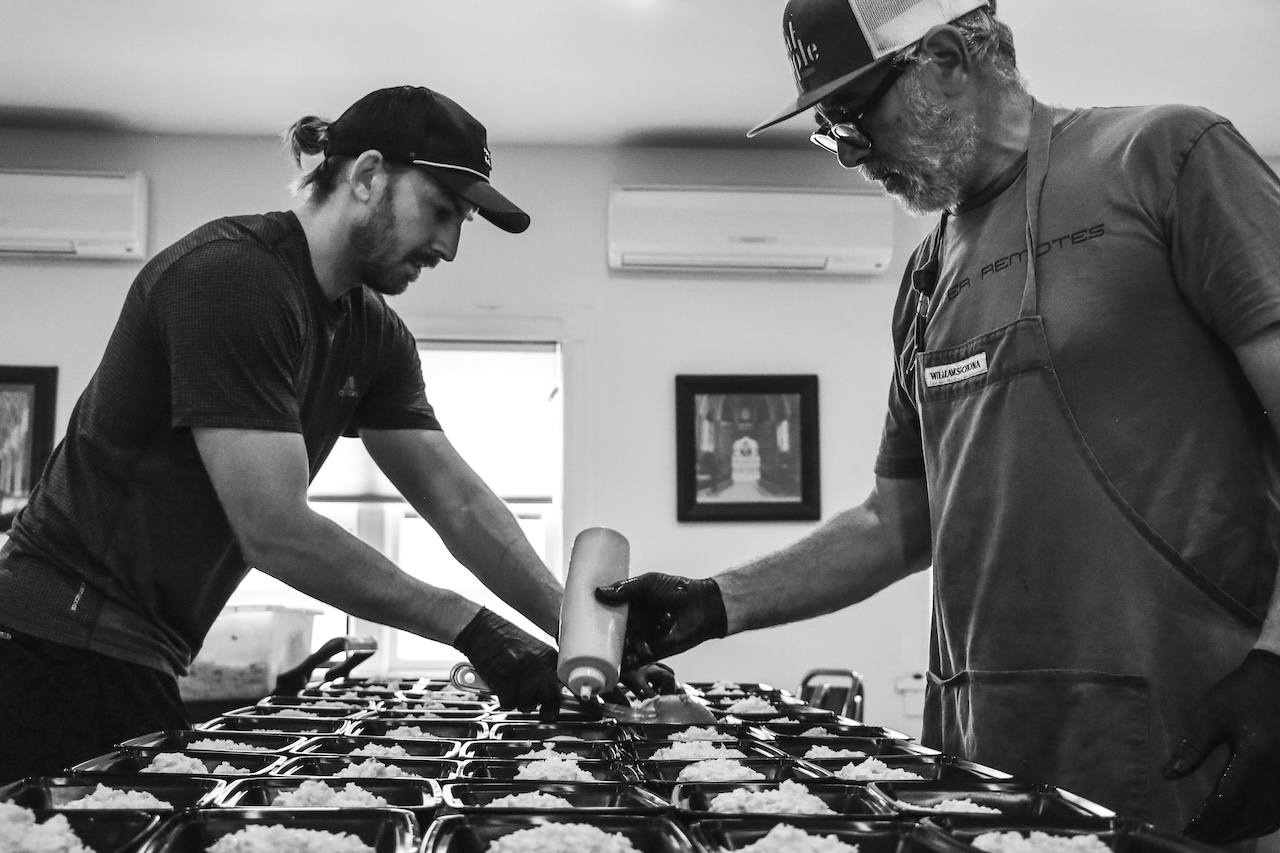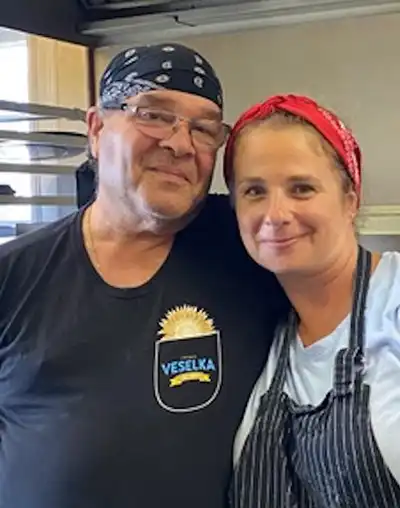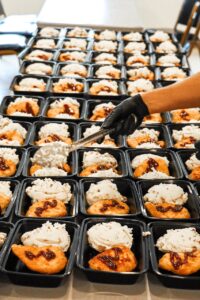This Month’s Featured Article

Columbia County Recovery Kitchen Tackles Food Insecurity in Columbia County
Carole Clark worked in the restaurant industry for over 30 years – 19 of which were in Hudson, NY – so feeding people was something that she was more than familiar with. While she wasn’t working in the restaurant business at the start of the pandemic, she had been the chef proprietor of Charleston Restaurant in Hudson for many years previously and felt that she had to do something when the pandemic hit.
“I knew a lot of families in Hudson who were food insecure before COVID, so I knew their lives would be severely impacted. That also included my staff,” Carole said. “I had to do something.”
Carole immediately went into action. She wanted to provide whole, nutritious meals for the food-insecure community members; all she needed was a kitchen and some help. The first meals were actually cooked in her own home. She reached out to two chefs that she knew were out of work due to the pandemic, and they brought even more former restaurant staff with them. “We started doing 200 meals a week in a small kitchen that was provided by the Christ Church Episcopal on Union Street in Hudson,” Carole said. They are still located there today.
“The whole thing was charmed from the beginning,” she further explained. “Every person I called to ask for help said yes.”
Thus, the Columbia County Recovery Kitchen was born.

Expansion
Since its start in 2020, the Recovery Kitchen has grown in every way. “The most important part is the enormous number of volunteers that we have,” Carole said. The Recovery Kitchen currently has two full-time chefs and over 100 volunteers, and the list keeps growing.
“We’ve actually had to put people on a substitute list because we have so many regular volunteers,” Carole said. “That has just been amazing.”
The Recovery Kitchen was able to hire an executive director, Jolene Race, in February. Jolene previously served as the director of the Columbia County Solid Waste Department. When she retired in December of 2023, she felt that she wasn’t done working just yet.
“I had known about the organization, and when I saw the listing, I thought I could be a good fit,” she said. “I remember saying to Carole, ‘you’ve got a dream and it’s my job to make it happen.’”
The Columbia County Recovery Kitchen works with various agencies for referrals, including the department of social services, schools, clinics and doctors, among others. Self referrals are also accepted.
“Outreach is really what we’re trying to ramp up moving forward. We’re focusing on how to get the word out to people in need,” Jolene said. “I didn’t realize how many people are in need in this area. If it’s not in your scope, it’s not necessarily something you’re thinking about.”
According to the Recovery Kitchen’s website, 11.5% of Columbia County’s population of 60,000 struggles with food insecurity and 16.5% of Columbia County children are hungry.
Generally speaking, the criteria goes by need and ability to get food. Many times, Jolene said that elderly people aren’t necessarily looking for a free meal, but simply looking for someone to deliver the meal to them because they can’t drive or can’t get out.
“That’s where we need to expand outreach because so much of our elderly population is located in rural parts of the county,” she said. “A lot of our drivers that deliver meals are guardians in a way, too. They notice if someone doesn’t open the door or if they didn’t pick up their mail. They lobby for them in addition to delivering their meals.”
Carole agreed. “A lot of the rural poor are invisible. Many of them aren’t affiliated with churches or social services organizations, they just live out in the country, and they have limited transportation, so they can’t get around as easily.”
An average day
There are two full-time chefs at the Recovery Kitchen, Tommy Carlucci and Kathy Silliman. Tommy and Kathy work five days a week, typically starting their day around eight o’clock in the morning. Around nine o’clock, that day’s volunteers come in to help prep, cook, and package the meals.
In addition to the families in need that Recovery Kitchen serves, they also have agreements with the Hudson Youth Department and Columbia Opportunities’ Head Start, which means they have to be mindful of the children’s food allergies, dietary restrictions, and sensitivities.
Moreover, in addition to volunteers working in the kitchen, the Recovery Kitchen also has volunteers managing the spreadsheets of delivery routes and the 70 drivers who deliver the cost-free meals to people’s homes.
“Everybody shows up. It’s great,” Jolene said. “That just amazed me because coming from government, having employees is quite different from having volunteers. It’s incredible to see people in their twenties all the way up to their seventies come in and donate their time.”
The chefs behind the food
Tommy previously worked at the Blue Plate in Chatham, NY, and was working four days a week at the Chatham Food Co-op when he started volunteering for the Recovery Kitchen.
“We’ve grown so much and we’re still taking on individuals. We’re not saying no to anyone,” Tommy said.
On the Thursday that I stopped in, Tommy, Kathy, and the volunteers were busy packing up a hamburger helper-esque meal.
 “This is a fun meal. It’s hamburger helper using real cream, cheese, whole wheat pasta, local farm beef, and roasted peppers and onions. So we’re making it at a different level,” Tommy explained.
“This is a fun meal. It’s hamburger helper using real cream, cheese, whole wheat pasta, local farm beef, and roasted peppers and onions. So we’re making it at a different level,” Tommy explained.
The day before, they cooked up a chicken, egg noodle, and broccoli dish with a mushroom cream sauce.
“That’s a meal that you’re going to pay $20 or more for in a restaurant, and it’s no different from a recipe that I would make when I was working in restaurants. Our goal is to provide high quality, nutritious meals.”
Typically, Tommy tries to have Monday’s menu planned and shopped for by the Friday before. Then on Monday, he takes time to write out the meals for the remainder of the week.
“Sometimes I only have Monday through Wednesday planned, and sometimes it’s rotating meals that we know work and putting a bit of a spin on them. We might make this same meal, but on a different day,” he said.
Tommy has some limitation as to how much space he has for storage in the kitchen, which means that he’s shopping daily. “A year ago, Carole asked me what I thought I could do here, and I told her that I thought we’d be really hard pressed to do more than 1,200 meals a week. A year later, we’re doing 1,600 meals a week in the same space,” he said.
For Tommy, this is the most rewarding work he’s ever done. “I feel so lucky. I wish I had been doing this for twenty years. This is what I was meant to be doing. It took a fifty-year career to get here.”
Kathy knew Tommy from working as a chef. She started volunteering at the Recovery Kitchen one day a week a year ago. “I wasn’t happy at my current job, and Tommy said he needed help here. I fell in love with it. We kept growing and growing, so what started as a one day a week volunteer position turned into a five day a week full-time position,” she said.
For Kathy, the most rewarding part of working at the Recovery Kitchen is the relationships that she’s built with the people that she works with. Oh yeah, and making 1,600 meals a week for those in need is pretty awesome, too.
“I’m a single mom. Sometimes I think to myself, ‘oh my god, how am I going to do this?’ It can seem impossible. But then I come here, and I see our numbers growing every week, and I realize that I am doing a good job. We meet people who are living in hotels with their children and displaced from their communities and their schools, and I’m very fortunate that we have a stable life,” she said. “It’s just a no-brainer for me. It’s the most rewarding job I’ve ever had.”
At the Recovery Kitchen, Kathy gets to be creative, too. They frequently get donations from farmers, so if one day they get 20 pounds of pork cheek donated, the cooks have to adapt their recipes to accommodate that donation. “What are we going do with that? We have to figure it out because we have to cook it and move it,” she said.
Additionally, if they have any meals left over at the end of each day, they donate them to the community fridges in Hudson. “We used to be able to do more for the community fridges, but we have extra groups to cook for now. As far as the kids are concerned, a large percentage of them have dietary restrictions, so if we can’t feed something to the kids, it’ll go to the fridges. We use everything we can.”
Echoing Tommy’s concerns, Kathy agreed that space and time are the two biggest challenges. Without proper storage, they aren’t able to house as many ingredients or to store the food, which means they’re working day-to-day and can’t necessarily get ahead during the week.
However, she noted that they are not short of volunteers. “We started a substitute list because so many people wanted to help. That’s how dedicated these people are to their work, and that just goes back to the most rewarding part. It’s the people.”
Kathy said she’ll never go back to working in a restaurant. “This matters. I will never go back to wanting to make fancy food for privileged people. I would rather make hamburger helper for 293 people that otherwise might not eat anything today.”
Jimmy Jagmin started volunteering as a cook at the Recovery Kitchen about a year ago, after he met Carole at the local farmer’s market. “A personal philosophy for me is that sharing a meal with somebody is the most sacred thing, so being able to provide food for people that are in need is the way that I feel like I can give back the most,” he said. “All of the volunteers are great, and it’s a great cause. This community has a lot of people in need. Oh, and Kathy and Tommy are hilarious and really fun, too.”
Farm liaison
Nancy Kuster is a friend of Carole’s and started volunteering at the Recovery Kitchen at its inception in 2020.
Nancy also serves as the farm liaison for the Recovery Kitchen, which means her primary responsibilities are building relationships with local farms and managing donations. 
“I’ve worked on farms, so I have a lot of connections in the area,” she said. “Last year, we had a volunteer program at the farm I work at in which half of what the volunteers harvested at the farm would go to the farm and the other half would be donated to the Recovery Kitchen.”
The Recovery Kitchen works with a long list of farms in the area, among them Churchtown Dairy, Fat Apple Farm in Pine Plains, Green Acres Farm in Hudson, and Hawthorne Valley Farm, among many, many others. A full list of farm partners is available on its website.
Currently, Nancy is applying for a variety of grants that would allow the Recovery Kitchen to pay local farms for the food they donate.
“We’re working on some fundraising to help pay them as well,” she said. “It’s harder and harder for farmers to make a living and afford to live in this area, so if we can support them and reciprocate in some way, we want to do that. We want good food, but it’s not fair to expect them to just give it to us. Everything is too expensive now.”
The most rewarding part for Nancy is getting healthy, local food to people who are hungry and malnourished.
“Carole’s always open to different ideas and opportunities. She’s a force of nature and it’s amazing what she’s been able to accomplish,” she said. “We just keep making changes as needed. If things aren’t working, we try something new.”
Looking long-term
Carole and Jolene would like to continue to expand the program and find more space with a bigger kitchen. Additionally, they’re looking into expanding into other parts of Columbia County.
“We want to serve a larger part of the food-insecure population. Even though we’re doing 1,600 meals, we’re only serving a fraction of the population that is food insecure,” Carole said. “We’d like to be doing 3,000 meals a week.”
Another thing they’d like to expand is their relationships with local farms. “This community is agricultural. While we have already built relationships with 26 farms in the area, we’d like to work with others.”
Carole also noted that what they do at the Recovery Kitchen is replicable and that they’d be more than willing to work with other counties to help them create their own Recovery Kitchen programs.
The Recovery Kitchen is always looking for volunteers in various capacities including grant writing, scheduling, website design, graphic designers, drivers, marketers, and many more.
“Anyone, really. We’ll find something for you to do,” Carole smiled. The easiest way to show your interest in volunteering is to apply on the website or email Carole at info@columbiacountyrecoverykitchen.org.
For Carole, the most rewarding part of the past four years has been providing better nutrition for those who truly need it. “That’s the most gratifying part. Doing whatever you can to combat hunger is what I feel is most important. Many of these people are nutrition insecure as well, so knowing that we’re helping to provide better nutrition and whole foods is key.” •
To learn more about the Columbia County Recovery Kitchen, visit its website columbiacountyrecoverykitchen.org, or follow it on Instagram @ccrecoverykitchen.


